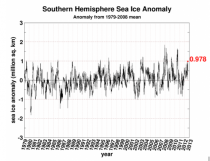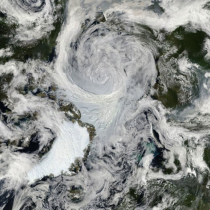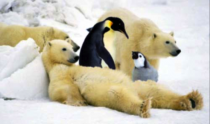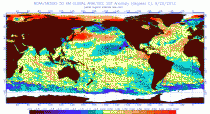By Joe D’Aleo
UPDATE: Jeff Masters of the Weather Underground says the water off Antarctica is warming faster than any place on earth. Check out this NOAA SSTA map. Dream on Jeff. He is now where he belongs - The Weather Channel.
We hear a constant hyping of the new low arctic ice record and the ignoring of the simultaneous increase of Antarctic ice which appears heading towards a near new record high.
To these so called scientists and the media, the world began in 1979 when satellite tracking began, The famous picture of the submarine Skate surfacing at the North Pole in August 1959 shows this has happened before.

Steve Goddard over at Real Science many such examples of distress by scientists and the media about loss of arctic ice in the first half of the 1900s here and here.
The last arctic minimum in 2007 coincided with the southern hemisphere record high, which never was acknowledged. Here is today’s Southern Hemisphere ice anomaly chart.

Also note a new paper finds Antarctic Peninsula has accumulated significant extra ice since 1850
A paper published in Geophysical Research Letters finds the Antarctic Peninsula has experienced a “significant accumulation” of “up to 45 meters of extra ice thickness over the past 155 years.” This finding is contrary to the claims of the highly-flawed study published by RealClimate’s Dr. Eric Steig, which alleged that the Antarctic Peninsula is rapidly warming. The finding is particularly surprising since the “significant accumulation” of ice has occurred since the end of the Little Ice Age in ~ 1850.
Increased ice loading in the Antarctic Peninsula since the 1850s and its effect on Glacial Isostatic Adjustment
Key Points
- Accumulation increase results in up to 45 m extra ice thickness over 155 years
- Model predicts GIA-related subsidence of up to 7 mm/yr which will affect GPS
- GRACE-derived rates of ice-mass change are biased low by ignoring this signal
Authors: Grace A. Alexandra Nield, Pippa L. L Whitehous, Matt A. A King, Peter J. J Clarke, Michael J. J Bentley
ARCTIC ICE
On October 21st in 2011, the Associated Press hit the wires with a story entitled “Sea Ice Melting as Arctic Temperatures Rise.” This summer, numerous stories have appeared in newspapers and magazines about this year’s record. Part of this related to the arctic storm which broke up the ice.

The stories inevitably talked about the threat to the polar bears and some even penguins. Here they are photo shopped together although penguins are not found at the North Pole or polar bears Antarctica (for which the penguins are grateful because they would not exist if they did).

The temperatures in the arctic have indeed risen in recent years and ice has declined, bottoming out in 2007 but it is not unprecedented or unexpected. The arctic temperatures and arctic ice extent varies in a very predictable 60-70 year cycle that relates to ocean cycles which are likely driven by solar changes.
In 2007, NASA scientists reported that after years of research, their team had assembled data showing that normal, decade-long changes in Arctic Ocean currents driven by a circulation known as the Arctic Oscillation was largely responsible for the major Arctic climate shifts observed over the past several years. These periodic reversals in the ocean currents move warmer and cooler water around to new places, greatly affecting the climate. The AO was at a record low level last winter explaining the record cold and snow in middle latitudes. A strongly negative AO pushes the coldest air well south while temperatures in the polar regions are warmer than normal under blocking high pressure. See post here.
We agree. And indeed both oceans play a role. In the record-setting (since satellite monitoring began in 1979) summer melt season of 2007, NSIDC noted the importance of both oceans in the arctic ice.
“One prominent researcher, Igor Polyakov at the University of Fairbanks, Alaska, points out that pulses of unusually warm water have been entering the Arctic Ocean from the Atlantic, which several years later are seen in the ocean north of Siberia. These pulses of water are helping to heat the upper Arctic Ocean, contributing to summer ice melt and helping to reduce winter ice growth.
Another scientist, Koji Shimada of the Japan Agency for Marine-Earth Science and Technology, reports evidence of changes in ocean circulation in the Pacific side of the Arctic Ocean. Through a complex interaction with declining sea ice, warm water entering the Arctic Ocean through Bering Strait in summer is being shunted from the Alaskan coast into the Arctic Ocean, where it fosters further ice loss. Many questions still remain to be answered, but these changes in ocean circulation may be important keys for understanding the observed loss of Arctic sea ice.”

Read MUCH more here.



